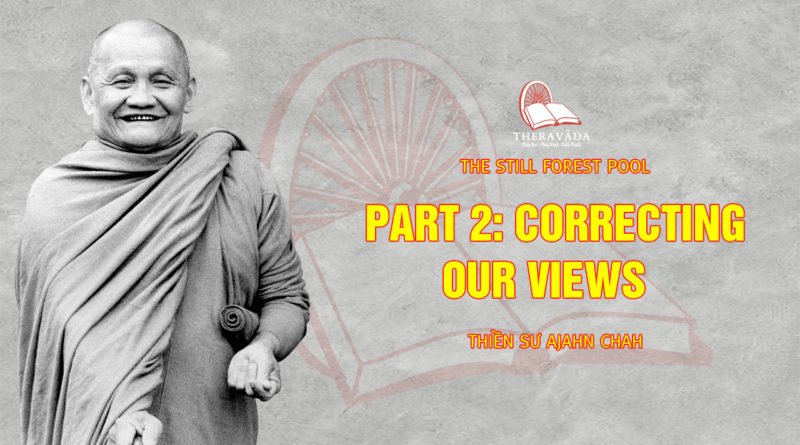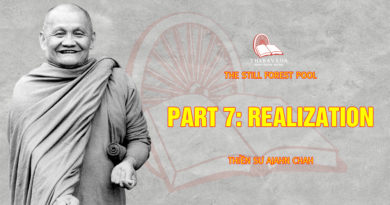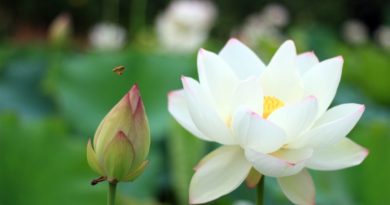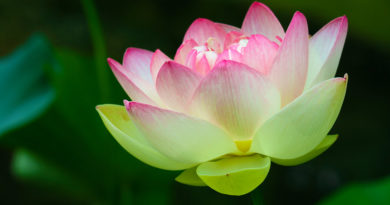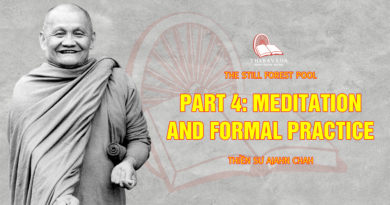The Still Forest Pool – Part 2 – Correcting Our Views
PART 2
Correcting Our Views
When you pick mushrooms, Achaan Chah cautions, you must know what to look for. When you undertake spiritual practice you must also know what attitudes to nourish, what dangers to avoid, and what mental qualities to encourage.
Here he emphasizes the power of training our endurance and courage, developing a willingness to find the Middle Path and follow it despite temptation and defilement. When greed, hatred, or delusion arise, he says, don’t give in to them. Don’t be discouraged. Just stay mindful and strong in your resolve.
As your training develops you will see that every single experience you pass through is impermanent, and thus unsatisfactory. You will discover firsthand the end less truth of these characteristics in all existence and begin to learn the way of freedom, of nonattachment. But Achaan Chah reminds us that this requires a willingness to investigate both our sufferings and our joys with an equal mind.
When the heart becomes calm and the mind clear, we come closer to the truth of what Achaan Chah calls, “Just that much.” The Dharma, the truth, is really very simple. All things that arise and pass, the whole world of changing phenomena, is really only “that much!” When we truly discover what this means, then here in our world we can come to peace.
The Wrong Road
A wandering ascetic, having heard of the Buddha, traveled everywhere looking for him. One night he came to stay in a house where the Buddha was also staying but, not knowing the Buddha’s physical appearance, he was unaware of his presence. The next morning he arose and continued on his way, still searching for the Buddha. To search for peace and enlightenment without correct understanding is like this.
Due to a lack of understanding of the truth of suffering and its elimination, all the subsequent factors on the path will be wrong-wrong intentions, wrong speech, wrong actions, and wrong practice of concentration and tranquility. Your likes and dislikes are not a trustworthy guide in this matter either, although foolish people may take them for their ultimate reference. Alas, it is like traveling to a certain town you unknowingly start out on the wrong road, and since it is a convenient one, you travel it in comfort. But it will not take you where you want to go.
Right Understanding
One develops right understanding by seeing impermanence, suffering, and not-self in everything, which leads to detachment and loss of infatuation. Detachment is not aversion. An aversion to something we once liked is temporary, and the craving for it will return.
Imagine some food that you like-bamboo shoots or sweet curry, for example. Imagine having it everyday for five or six years; you would get tired of bamboo shoots. If someone were to offer you some, you would not get excited. In the same way, we should see impermanence, suffering, and emptiness in all things at all times: bamboo shoots!
We seek not for a life of pleasure, but to find peace. Peace is within oneself, to be found in the same place as agitation and suffering. It is not found in a forest or on a hilltop, nor is it given by a teacher. Where you experience suffering, you can also find freedom from suffering. To try to run away from suffering is actually to run toward it. Investigate suffering, see its causes, and put an end to them right now, rather than merely dealing with their effects.
Starving Defilements
Those just beginning often wonder what practice is. Practice occurs when you try opposing the defilements, not feeding old habits. Where friction and difficulty arise, that’s the place to work.
When you pick mushrooms to eat, you do not do so blindly; you have to know which kind is which. So too with our practice-we must know the dangers, the snake’s bite of defilements, in order to free ourselves from them.
The defilements-greed, hatred and delusion-are at the root of our suffering and our selfishness. We must learn to overcome them, to conquer and go beyond their control, to become masters of our minds. Of course it seems hard. It is like having the Buddha tell you to split up with a friend you have known since childhood.
The defilements are like a tiger. We should imprison the tiger in a good strong cage made of mindfulness, energy, patience, and endurance. Then we can let it starve to death by not feeding its habitual desires. We do not have to take a knife and butcher it.
Or defilements are like a cat. If you feed it, it will keep coming around. Stop feeding it, and eventually it will not bother to come around any more.
We will unavoidably be hot and distressed in our practice at first. But remember, only the defilements are hot. People think, ‘1 never had problems like this before. What’s wrong?” Before, when we fed our desires, we were at peace with them, like a man who takes care of an internal infection by dressing only the external sores.
Resist defilements. Do not give them all the food or sleep they want. Many people consider this the extreme of self-torture, but it is necessary to become inwardly strong. See for yourself. Constantly watching the mind, you may think you are seeing only effects and wonder about the causes. Suppose parents have a child who grows up to be disrespectful. Distressed by his behaviour, they may ask, ‘Where has this child come from?” Actually, our suffering comes from our own wrong understanding, our attachment to various mental activities. We must train our mind like a buffalo: the buffalo is our thinking, the owner is the meditator, raising and training the buffalo is the practice. With a trained mind, we can see the truth, we can know the cause of our self and its end, the end of all sorrow. It is not complicated, you know.
Everyone has defilements in his practice. We must work with them, struggling when they arise. This is not something to think about but to do. Much patience is necessary. Gradually we have to change our habitual ways of thinking and feeling. We must see how we suffer when we think in terms of me and mine. Then we can let go.
Happiness and Suffering
A young Western monk had just arrived at one of Achaan Chah’s forest monasteries and asked permission to stay and practice.
I hope you’re not afraid of suffering” was Achaan Chah’s first response.
Somewhat taken aback, the young Westerner explained that he did not come to suffer but to learn meditation and to live peacefully in the forest.
Achaan Chah explained, ”There are two kinds of suffering: the suffering that leads to more suffering and the suffering that leads to the end of suffering. If you are not willing to face the second kind of suffering, you will surely continue to experience the first.”
Achaan Chah’s way of teaching is usually straightforward and direct. When he meets his monks on the monastery grounds, he often asks, “Are you suffering much today?” If one answers yes, he replies, ‘Well, you must have many attachments today,” and then laughs with the monk about it.
Have you ever had happiness? Have you ever had suffering? Have you ever considered which of these is really valuable? If happiness is true, then it should not dissolve, should it? You should study this point to see what is real, what is true. This study, this meditation, leads to right understanding.
The Discriminating Mind
Right understanding ultimately means non-discrimination-seeing all people as the same, neither good nor bad, neither clever nor foolish; not thinking that honey is sweet and good and some other food is bitter. Although you may eat several kinds of food, when you absorb and excrete them, they all become the same. Is it one or many? Is a glass big? In relation to a little cup, yes; when placed next to a pitcher, no.
Our desire and ignorance, our discrimination color everything in this way. This is the world we create. Again, a pitcher is neither heavy nor light; we just feel that it is one way or the other. In the Zen koan of the flag in the wind, two persons are watching a flag: one says it is the wind that moves, the other says it is the flag. They can argue forever, take sticks and fight it out, all to no avail, for it is the mind that moves.
There are always differences. Get to know those differences, yet learn to see the sameness too. In our group people come from different backgrounds, different cultures. Yet without thinking, ‘This one’s Thai, that one’s Lao, he’s Cambodian, he’s a Westerner,” we should have mutual understanding and respect for the ways of others. Learn to see the underlying sameness of all things, how they are all truly equal, truly empty. Then you can know how to deal with the apparent differences wisely. But do not get attached even to this sameness.
Why is sugar sweet and water tasteless? It is just their nature. So too with thinking and stillness, pain and pleasure-it is wrong understanding to want thinking to cease. Sometimes there is thought, sometimes stillness. We must see that both are by nature impermanent, unsatisfactory, not a cause for lasting happiness. But if we continue to worry and think further, ‘1 am suffering, I want to stop thinking,” this wrong understanding only complicates things.
At times, we may feel that thinking is suffering, like a thief robbing us of the present. What can we do to stop it? In the day, it is light; at night, it is dark. Is this itself suffering? Only if we compare the way things are now with other situations we have known and wish it were otherwise. Ultimately things are just as they are-only our comparisons cause us to suffer.
You see this mind at work-do you consider it to be you or yours? “I don’t know if it’s me or mine,” you answer, “but it’s certainly out of control.” It is just like a monkey jumping about senselessly. It goes upstairs, gets bored, runs back downstairs, gets tired of that, goes to a movie, gets bored again, has good food or poor food, gets bored with that too. Its behavior is driven not by dispassion but by different forms of aversion and fear.
You have to learn control. Stop caring for the monkey-care for the truth of life instead. See the real nature of the mind: impermanent, unsatisfactory, empty. Learn to be its master; chain it down if you must. Do not just follow it, let it wear itself out and die. Then you have a dead monkey. Let the dead monkey rot away, and you have monkey’s bones.
Still enlightenment does not mean to become dead like a Buddha statue. One who is enlightened thinks also but knows the process as impermanent, unsatisfactory, and empty of self. We who practice must see these things clearly. We need to investigate suffering and stop its causes. If we do not see it, wisdom can never arise. There should be no guesswork, we must see things exactly as they are-feelings are just feelings, thoughts are just thoughts. This is the way to end all our problems.
We can see the mind as a lotus. Some lotuses are still stuck in the mud, some have climbed above the mud but are still underwater, some have reached the surface, while others are open in the sun, stain-free. Which lotus do you choose to be? If you find yourself below the surface:, watch out for the bites of fishes and turtles.
Sense Objects and the Mind
We do not examine ourselves; we just follow desire, caught in endless rounds of grasping and fearing, wanting to do just as we please. Whatever we do, we want it to be at our ease. If we are not able to have comfort and pleasure any longer, we are unhappy, anger and aversion arise, and we suffer, trapped by our mind.
For the most part, our thinking follows sense objects, and, wherever thought leads us, we follow. However, thinking and wisdom are different; in wisdom, the mind becomes still, unmoving, and we are simply aware, simply acknowledging. Normally, when sense objects come, we think about, dwell on, discourse over, and worry about them. Yet none of those objects is substantial; all are impermanent, unsatisfactory, and empty. Just cut them short and dissect them into these three common characteristics. When you sit again, they will arise again, but just keep observing them, keep checking them out.
This practice is like caring for a buffalo and a rice field. The mind is like the buffalo that wants to eat the rice plants, sense objects; the one who knows is the owner. Consider the comparison. When you tend a buffalo, you let it go free but you keep watch over it. You cannot be heedless. If it goes close to the rice plants, you shout at it and it retreats. If it is stubborn and will not obey your voice, you take a stick and hit it. Do not fall asleep in the daytime and let everything go. If you do, you will have no rice plants left, for sure.
When you are observing your mind, the one who knows constantly notices all. As the sutras say, “He who watches over his mind shall escape the snares of Mara the Evil One.” Mind is mind, but who is it that observes it? Mind is one thing, the one who knows is another. At the same time the mind is both the thinking process and the knowing. Know the mind-know how it is when it meets sense objects and how it is when it is apart from them. When the one who knows observes the mind in this way, wisdom arises. If it meets an object, it gets involved, just like the buffalo. Wherever it goes, you must watch it. When it goes near the rice plants, shout at it. If it will not obey, just give it the stick.
When the mind experiences sense contact, it grabs hold. When it grabs hold, the one who knows must, teach it-explaining what is good and what is bad, pointing out the workings of cause and effect, showing that anything it holds on to will bring undesirable results until mind becomes reasonable, until it lets go. In this way, the training will take effect, and the mind will become tranquil.
The Buddha taught us to lay everything down, not like a cow or a buffalo but knowingly, with awareness. In order for us to know, he taught us to practice much, develop much, rest firmly on the principles of the Buddha, Dharma, and Sangha, and apply them directly to our own life.
From the beginning I have practiced like this. In teaching my disciples, I teach like this. We want to see the truth not in a book or as an ideal but in our own minds. If the mind is not yet free, contemplate the cause and effect of each situation until the mind sees clearly and can free itself from its own conditioning. As the mind becomes attached again, examine each new situation-do not stop looking, keep at it, drive the point home. Then attachment will find no where to rest. This is the way I myself have practiced.
If you practice like this, true tranquility is found in activity, in the midst of sense objects. At first, when you are working on your mind and sense objects come, you cling to them or avoid them. You are therefore disturbed, not peaceful. When you sit and wish not to have sense contact, not to have thinking the very wish not to have is desire. The more you struggle with your thinking, the stronger it becomes. Just forget about it and continue to practice. When you make contact with sense objects, contemplate: impermanent, unsatisfactory, not self. Throw everything into these three pigeonholes, file everything under these three categories, and keep contemplating.
Problems of the World
Many people, particularly educated, professional people, are moving out of the big cities, seeking quieter living and simpler livelihood in the small towns and rural areas. This is natural. If you grab a handful of mud and squeeze it, it will ooze through your fingers. People under pressure likewise seek a way out.
People ask me about the problems of our world, about a corning apocalypse. I ask, what does it mean to be worldly? What is the world? You do not know? This very unknowing, this very darkness, this very place of ignorance, is what is meant by worldly. Caught in the six senses, our knowledge develops as a part of this darkness. To come to an answer to the problems of the world, we must know its nature completely and realize the wisdom that shines above the darkness of the world.
These days, it seems that our culture is deteriorating, lost in greed, hatred, and delusion. But the culture of the Buddha never changes, never diminishes. It says, “Do not lie to others or to ourselves. Do not steal from others or from ourselves.” Worldly culture has desire as its director and guide. The culture of the Buddha has compassion and Dharma, or truth, as its guide.
Just That Much
When you take a good look at it, this world of ours is just that much; it exists just as it is. Ruled by birth, aging, sickness, and death, it is only that much. Great or little is only that much. The wheel of life and death is only that much. Then why are we still attached, caught up, not removed? Playing around with the objects of life gives us some enjoyment; yet this enjoyment is also just that much.
Whatever is pleasurable, delicious, exciting, good, is just that much; it has its limit, it is not as if it is anything outstanding. The Buddha taught that everything is just that much, of equal value. We should contemplate this point. Just look at the Western monks who
have come here to practice. They have experienced much pleasure and comfort in their lives, but it was only that much; trying to make more of it just drove them crazy. They became world travelers, let everything go-it was still only that much. Then they carne
here to the forest to learn to give it all up, all attachments, all suffering.
All conditioned things are the same-impermanent, caught up in the cycle of birth and death. Just look at them; they are only that much. All things in this world exist thus. Some people say, ”Doing virtuous deeds, practicing religion, you grow old just the same.” This may be true of the body, but not of the heart, of virtue; when we understand the difference, we have a chance to become free.
Look at the elements of our body and mind. They are conditioned phenomena, arising from a cause and therefore impermanent. Their nature is always the same, it cannot be changed. A great noble and a common servant are the same. When they become old, their act comes to an end; they can no longer put on airs or hide behind masks. There is nowhere to go, no more taste, no more texture. When you get old, your sight becomes dim, your hearing weakens, your body becomes feeble-you must face yourself.
We human beings are constantly in combat, at war to escape the fact of being just that much. But instead of escaping, we continue to create more suffering, waging war with good, waging war with evil, waging war with what is small, waging war with what is big, waging war with what is short or long or right or wrong, courageously carrying on the battle.
The Buddha taught the truth, but we are like buffalo-unless they are tied down firmly by all four legs, they will not allow themselves to be given any medicine. Once they have been tied down and cannot do anything-aha, now you can go ahead and give them medicine, and they are unable to struggle away. In the same way, most of us must be totally bound up in suffering before we will let go and give up our delusions. If we can still writhe away, we will not yet give in. A few people can understand the Dharma
when they hear it taught and explained by a teacher. But life must teach most of us all the way to the end.
You can pull on the end of a rope, but if the other end is stuck, the rope will never budge. In order to make it come free, you need to find out where it is stuck, you need to seek out the source or the root of the problem. We must use our practice fully to discover how we are stuck, to discover the heart of peace. We must follow the ox’s tracks from the beginning, from the point at which it left the corral. If we start in the middle of the trail, we will not be able to tell whose ox’s tracks they are, and thus we could be led anywhere.
Therefore, the Buddha spoke of first correcting our views. We must investigate the very root of suffering, the very truth of our life. If we can see that all things are just that much, we will find the true Path. We must come to know the reality of conditioned phenomena, the way things are. Only then can we have peace in our world.
Follow Your Teacher
As you grow in Dharma, you should have a teacher to instruct and advise you. The matter of concentrating the mind, of samadhi, is much misunderstood; phenomena occur in meditation that otherwise do not normally arise. When this happens, a teacher’s guidance is crucial, especially in those areas in which you have wrong understanding. Often where he corrects you will be just where you thought you were right. In the complexity of your thinking, one view may obscure the other and you get fooled. Respect your teacher and follow the rules or system of practice. If the teacher says to do something, do it. If he says to desist, desist. This allows you to make an honest effort and leads to making knowledge and vision manifest in your mind. If you do as I am saying, you will see and know.
True teachers speak only of the difficult practice of giving up or getting rid of the self. Whatever may happen, do not abandon the teacher. Let him guide you, because it is easy to forget the Path.
Alas, few who study Buddhism really want to practice. I certainly urge them to practice, but some people can only study in a logical way. Few are willing to die and be born again free. I feel sorry for the rest.
Trust Your Heart
In the practice of Dharma, there are many methods; if you know their point, they will not lead you astray. However, if you are a practitioner who does not properly respect virtue and a collected mind, you will not succeed, because you are bypassing the Path followed by the great forest masters of the past. Do not disregard these basics. If you wish to practice, you should establish virtue, concentration, and wisdom in your mind and aspire to the Three Gems-Buddha, Dharma, and Sangha. Stop all activity, be an honest person, and go to it. Although various things deceive you time after time, if you are aware of them, you will eventually be able to drop them. The same old person comes telling the same old lies; if you know it, you need not believe him. But it takes a long time before you know; our habits are ever striving to deceive.
When I had been practicing for only two or three years, I still could not trust myself. But after I had experienced much, I learned to trust my own heart. When you have this deep understanding, whatever occurs, you can let it occur, and all things will pass on and be quelled. You will reach a point where the heart tells itself what to do; it is constantly prodding, constantly mindful. Your only concern need be to continue contemplating.
Why Do You Practice?
A group of travelers came to visit Achaan Chah with three elegant questions: Why do you practice? How do you practice? What is the result of your practice? They were sent as a delegation by a European religious organization to ask these questions to a series of great masters throughout Asia.
Achaan Chah closed his eyes, waited, and then answered with three questions of his own: Why do you eat? How do you eat? How do you feel after you have eaten well? Then he laughed.
Later, he explained that we already understand and that teaching has to direct students back to their own inner wisdom, to their own natural Dharma. Therefore, he had reflected the search of these men throughout Asia back to the greater search within.
Let the Tree Grow
The Buddha taught that with things that come about of their own, once you have done your work, you can leave the results to nature, to the power of your accumulated karma. Yet your exertion of effort should not cease. Whether the fruit of wisdom comes quickly or slowly, you cannot force it, just as you cannot force the growth of a tree you have planted. The tree has its own pace. Your job is to dig a hole, water and fertilize it, and protect it from insects. That much is your affair, a matter of faith. But the way the tree grows is up to the tree. If you practice like this, you can be sure all will be well, and your plant will grow.
Thus, you must understand the difference between your work and the plant’s work. Leave the plant’s business to the plant, and be responsible for your own. If the mind does not know what it needs to do, it will try to force the plant to grow and flower and give fruit in one day. This is wrong view, a major cause of suffering. Just practice in the right direction and leave the rest to your karma. Then, whether it takes one or one hundred or one thousand lifetimes, your practice will be at peace.
Too Much of a Good Thing
When Achaan Chah arrived at a new American meditation center, the many Western students there were quickly charmed and impressed by his teaching. He was clear and direct yet loving and humorous as he poked fun at people’s fears and attachments. It was exciting to have such a skilful and famous master visit. The new stories, golden-robed monks, and fresh expressions of Dharma were all wonderful. “Please do not go as soon as you planned, do try to stay a long time,” the students requested. “We are so happy to have you.”
Achaan Chah smiled. “Of course, things are nice when they are new. But if I stay and teach and make you work, you will get tired of me, won’t you? How is your practice when the excitement wears off? You would be bored with me before long. How does this restless, wanting mind stop? Who can teach you that? There only can you learn the real Dharma.”
____________________

